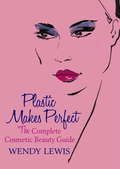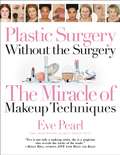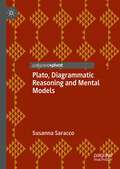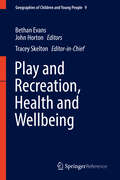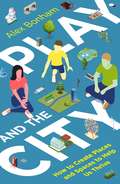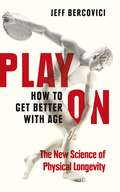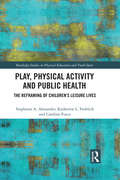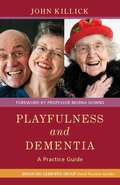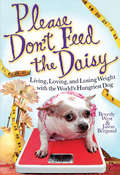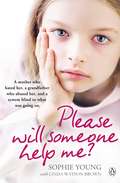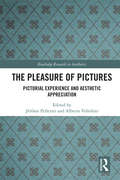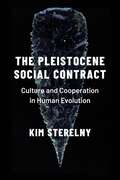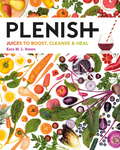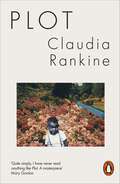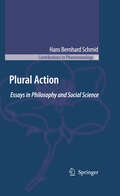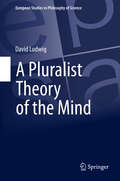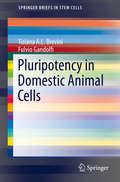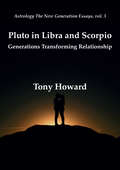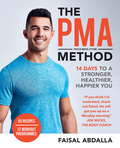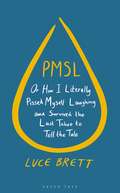- Table View
- List View
Plastic Makes Perfect: The Complete Cosmetic Beauty Guide
by Wendy LewisThe must-have guide to cosmetic surgery written by the world's leading independent consultant.Cosmetic surgery, once the preserve of the jet-setting rich, is now something more people than ever are prepared to consider, and the industry is worth almost £700 million in the UK alone. But what is involved, what are the risks and how much does it cost?This comprehensive guide by one of the world's leading experts outlines all the latest surgical procedures and non-invasive treatments and gives the facts you need to make an informed decision on whether it is right for you. Giving the reader the low down on the most popular cosmetic surgical procedures and the non-surgical alternatives, Wendy provides details on the very latest techniques and procedures, the questions to ask, the resources to help you find the best doctors, hints on speeding post-op recovery and the ways to negotiate potential pitfalls.Deciding to have a cosmetic procedure is a very personal journey to embark on. PLASTIC MAKES PERFECT is filled with expert but friendly advice on one of the most important life-altering decisions we can make.
Plastic Surgery (Health and Medical Issues Today)
by Lana ThompsonThis book provides a complete history of plastic surgery, a description of the modern techniques and choices available, and an overview of the controversies surrounding the choice to voluntarily change your physical appearance.Plastic surgery was historically considered a medical necessity. These were procedures specifically developed to treat burn or accident victims, to correct those born with cleft palates, or to repair extreme cases of cosmetic disfigurement, such as amputations performed as a punishment for adulterous men. Today, however, plastic surgery is a common option for those seeking to modify their normal and uninjured bodies to conform to an unrealistic, idealized model of perfection.This book presents the fascinating history of how therapeutic techniques were adapted to offer cosmetic changes to patients without disfiguring bodily flaws. The first section of Plastic Surgery details this evolution by tracing the history from development of the medical techniques to the choices currently available today. The second section digs deeper to examine the controversies and issues associated with plastic surgery, such as race, beauty, and gender reassignment. The third section offers primary documents produced by medical authorities regarding accepted procedures and practices, as well as an expansive glossary and timeline.
Plastic Surgery Without the Surgery: The Miracle of Makeup Techniques
by Eve PearlGet the glowing good looks of your dreams without plastic surgery, as revealed by Emmy Award-winning makeup artist Eve Pearl. Have you been contemplating Botox, eyelid surgery, or breast augmentation? A face-lift, nose job, or collagen injections? Save your money and avoid the risks! By applying the same Hollywood-insider methods used to make celebrities look years younger and show-stopping gorgeous, Eve Pearl shows you how to enhance your lips, diminish wrinkles, and even appear to go from an A-cup bra to a generous B or even C! Like a magic wand, makeup-done as you've never seen it before-will accentuate the uniqueness of your looks while disguising the flaws. With Eve Pearl's simple but amazing techniques, you can completely transform your face, eyes, brows, nose, lips, and breasts. And this powerful, safe way to a more youthful and natural beauty takes just minutes to achieve. Discover: The "face-lift" kit that tightens skin, brings out the eyes, and hides deep laugh lines around the nose and mouth Fantastic remedies for dark circles under the eyes, puffiness, and crow's-feet How to use moisturizers and foundations to create velvety, luminous skin tones-without the dangers of a chemical peel or bleaching Dramatic shading to produce elegant cheekbones and make a double chin disappear Techniques to make your breasts look larger (you won't believe your eyes!) Products to create fuller, more sensuous lips with a "sweetheart" shape and a luscious shine . . . and much more. From eye-lift to face-lift, you will be thrilled by the results -- without the pain, risk, or expense of surgery!
Plato, Diagrammatic Reasoning and Mental Models
by Susanna SaraccoThis book analyses the role of diagrammatic reasoning in Plato’s philosophy: the readers will realize that Plato, describing the stages of human cognitive development using a diagram, poses a logic problem to stimulate the general reasoning abilities of his readers. Following the examination of mental models in this book, the readers will reflect on what inferences can be useful to approach this kind of logic problem. Plato calls for a collaboration between writer and readers. In this book the readers will examine the connection between diagrams and discovery, realizing the important epistemic role of visualization. They will recognize the crucial role that diagrams play in problem solving. The logic problem elaborated by Plato is addressed considering the epistemic function of mental models. These models introduce to an advanced stage of cognitive development, in which reasoning uses in its investigations a higher-level of mathematical complexity, represented by structuralism.
Play and the City: How to Create Places and Spaces To Help Us Thrive
by Alex BonhamPlay is essential, for children but also adults. It's how we relax and revitalise ourselves, build and maintain friendships, try new things, learn and innovate.Cities have always been sites of play, bringing people together and pushing the boundaries of what is humanly possible. And now we need our cities to encourage and facilitate play of all kinds more than ever. If we want a world for our children to play in, we need to have a go at doing things differently. A city that is enjoyable to live in - that provides welcoming spaces, plentiful resources, and an attitude of 'yes, you can' - is a playful city. A city that is good for eight-year-olds as well as eighty-year-olds is a city that's good for all of us. By looking at how different cities across space and time have sought to encourage and facilitate play, Bonham shows us how to conceptualise our own contemporary city as a game, and encourages us to become participants rather than spectators.Play the city! Get involved, make a difference and help to bring your city back to life. There is help here to identify opportunities, build a team of friends and allies, take part - and win! It's time to make your move.
Play On: How to Get Better With Age
by Jeff BercoviciHow do the world's best athletes combat ageing, and what you can do to keep up?"Encouraging reading for jocks who are late to the game but committed to the win all the same." Kirkus Review "An energetic romp" that "smartly separates science from quackery." Publishers WeeklySports are about challenging our physical limits. But the greatest limit of all remains undefeated: age. Not, though, for the likes of Roger Federer, Tom Brady and Jo Pavey. What are they doing that you can too?Play On teaches us that it's not aging that causes a decline in fitness; rather, a decline in fitness causes aging.Full of cutting-edge science, technology and practical tips, Play On empowers you to reverse the ageing process, and stay younger for longer.
Play, Physical Activity and Public Health: The Reframing of Children's Leisure Lives (Routledge Studies in Physical Education and Youth Sport)
by Stephanie A. Alexander Katherine L. Frohlich Caroline FuscoAre children playing less than they used to? Are rising obesity rates linked to a decline in children’s time to play freely? These and other related questions have filled the pages of newspapers, magazines and scholarly journals for the past decade. Researchers and journalists have attributed these issues to societal changes around children’s lives and leisure, the growth of structured and organised activities and increasing perceptions of risk in children’s play. Play, Physical Activity and Public Health presents a discussion of the way modern notions of play are rendering children’s leisure activities less free and less engaged in simply for fun. Based on original qualitative research, and analysis of contemporary media from Canada and elsewhere, this book argues that the growing health concerns around childhood play entail a paradox: by advocating, promoting, discussing, and re-directing children’s play, a new form of children’s leisure is emerging - one that is purpose-driven, instrumentalised for health, and ultimately, less free. We explore how play has become goal-oriented, a means to health ends, and how the management of pleasure in play as well as diverse risk discourses around play continue to limit and constrain possibilities for children and families to play and engage in leisure freely. Incorporating past critiques of this trend in play, we argue for research and practice to create new possibilities and ways of thinking about children's play, leisure, fun and childhood, that are less constrained and managed, and importantly less geared towards health goals. This is a valuable resource for students of the sociology of sport, kinesiology, sports and health psychology, education, public health, and childhood studies. It is also an important read for school teachers, public health practitioners, psychologists, physical education teachers, academics and parents interested in how children’s leisure lives are being shaped by the growing and diverse discussions around play.
Play, Physical Activity and Public Health: The Reframing of Children's Leisure Lives (Routledge Studies in Physical Education and Youth Sport)
by Stephanie A. Alexander Katherine L. Frohlich Caroline FuscoAre children playing less than they used to? Are rising obesity rates linked to a decline in children’s time to play freely? These and other related questions have filled the pages of newspapers, magazines and scholarly journals for the past decade. Researchers and journalists have attributed these issues to societal changes around children’s lives and leisure, the growth of structured and organised activities and increasing perceptions of risk in children’s play. Play, Physical Activity and Public Health presents a discussion of the way modern notions of play are rendering children’s leisure activities less free and less engaged in simply for fun. Based on original qualitative research, and analysis of contemporary media from Canada and elsewhere, this book argues that the growing health concerns around childhood play entail a paradox: by advocating, promoting, discussing, and re-directing children’s play, a new form of children’s leisure is emerging - one that is purpose-driven, instrumentalised for health, and ultimately, less free. We explore how play has become goal-oriented, a means to health ends, and how the management of pleasure in play as well as diverse risk discourses around play continue to limit and constrain possibilities for children and families to play and engage in leisure freely. Incorporating past critiques of this trend in play, we argue for research and practice to create new possibilities and ways of thinking about children's play, leisure, fun and childhood, that are less constrained and managed, and importantly less geared towards health goals. This is a valuable resource for students of the sociology of sport, kinesiology, sports and health psychology, education, public health, and childhood studies. It is also an important read for school teachers, public health practitioners, psychologists, physical education teachers, academics and parents interested in how children’s leisure lives are being shaped by the growing and diverse discussions around play.
Playfulness and Dementia: A Practice Guide (PDF)
by Ian Cameron John Killick Kate Allan Nicola Hodge Robin Lang Sarah Zoutewelle-MorrisEstablishing playfulness as an essential component of dementia care, this positive and uplifting book will be key in changing attitudes and providing ideas for new and valuable ways of interacting and being with individuals with the condition. John Killick explores the nature of playfulness and the many ways in which it can enrich the lives of people with dementia, including as a means of maintaining relationships and communication, supporting communication and generally lifting the spirits. Specific approaches already in existence are described, including improvised drama, clowning and laughter yoga, and a chapter on the playful approach to art and craft activities is also included. Personal accounts of playfulness by individuals with dementia, relatives and an actor with a decade's experience of using playful approaches with people with dementia offer rich first-hand insights into its transformative potential. Throughout the book, the importance of spontaneity and of being with the person with dementia in the present moment is emphasised, and the reader is encouraged to develop a playful mindset. A selection of colour photographs amply demonstrate playful approaches in action. Offering a fresh and perhaps unexpected perspective, this book is essential reading for dementia care practitioners and managers, activity coordinators, therapists, people with dementia and their relatives, and anyone else concerned with the wellbeing of those with the condition.
Please Don't Feed the Daisy: Living, Loving, and Losing Weight with the World's Hungriest Dog
by Beverly WestWhen Jason moves in with Bev, it's supposed to be temporary. But then Daisy the Chihuahua comes to stay. Just two-and-a-half pounds when they adopt her, Daisy is a charmer. And soon, an eater. Hot on her heels comes Elvis the pug, and then, of course, their puppies! Instead of losing her baby weight, after giving birth to four puppies, Daisy gets even chubbier and soon outgrows even her fattest fat sweaters. Bev and Jason decide it's time for everyone, including the two of them, to pull together, lead a healthier life-style--and in the process become a family (albeit an unconventional one). Please Don't Feed the Daisy is the wickedly funny, remarkably useful story of their journey toward becoming that family, and a fit one to boot. Packed with yummy, fun, diet- and earth-friendly recipes for both dogs and people, as well as training tips and the Happily Ever After Maintenance Plan, this is a heartwarming and healthy tale for dog- (and food-) lovers everywhere.
Please Will Someone Help Me?
by Sophie YoungSophie Young tells her shocking true story in Please Will Someone Help Me?Sophie Young was born into a dysfunctional family, with a violent mother and father. Sophie was routinely neglected and harmed, starved and left to fend for herself. Social workers were often involved but, despite numerous visits and extensive reports, nothing was ever done.When Sophie was six, her life took another horrible turn: her adored grandfather began to sexually abuse her.Please Will Someone Help Me? is Sophie Young's heartbreaking story about a young girl at the mercy of the adult world. With full access to her social work files, she shows how those who are meant to help children can be blind to the reality of their lives; but how, ultimately, love conquers all.Sophie Young was the eldest of three, born into a dysfunctional family that she fought for years to escape. Now forty years old, she lives in England with her husband and children, and works as a volunteer for a national children's charity.
The Pleasure of Pictures: Pictorial Experience and Aesthetic Appreciation (Routledge Research in Aesthetics)
by Jérôme Pelletier Alberto VoltoliniThe general aim of this volume is to investigate the nature of the relation between pictorial experience and aesthetic appreciation. In particular, it is concerned with the character and intimacy of this relationship: is there a mere causal connection between pictorial experience and aesthetic appreciation, or are the two relata constitutively associated with one another? The essays in the book’s first section investigate important conceptual issues related to the pictorial experience of paintings. In Section II, the essays discuss the notion of styles, techniques, agency, and facture, and also take into account the experience of photographic and cinematic pictures. The Pleasure of Pictures goes substantially beyond current debates in the philosophy of depiction to launch a new area of reflection in philosophical aesthetics.
The Pleasure of Pictures: Pictorial Experience and Aesthetic Appreciation (Routledge Research in Aesthetics)
by Jérôme Pelletier Alberto VoltoliniThe general aim of this volume is to investigate the nature of the relation between pictorial experience and aesthetic appreciation. In particular, it is concerned with the character and intimacy of this relationship: is there a mere causal connection between pictorial experience and aesthetic appreciation, or are the two relata constitutively associated with one another? The essays in the book’s first section investigate important conceptual issues related to the pictorial experience of paintings. In Section II, the essays discuss the notion of styles, techniques, agency, and facture, and also take into account the experience of photographic and cinematic pictures. The Pleasure of Pictures goes substantially beyond current debates in the philosophy of depiction to launch a new area of reflection in philosophical aesthetics.
The Pleistocene Social Contract: Culture and Cooperation in Human Evolution
by Kim SterelnyKim Sterelny here builds on his original account of the evolutionary development and interaction of human culture and cooperation, which he first presented in The Evolved Apprentice (2012). Sterelny sees human evolution not as hinging on a single key innovation, but as emerging from a positive feedback loop caused by smaller divergences from other great apes, including bipedal locomotion, better causal and social reasoning, reproductive cooperation, and changes in diet and foraging style. He advances this argument in The Pleistocene Social Contract with four key claims about cooperation, culture, and their interaction in human evolution. First, he proposes a new model of the evolution of human cooperation. He suggests human cooperation began from a baseline that was probably similar to that of great apes, advancing about 1.8 million years ago to an initial phase of cooperative forging, in small mobile bands. Second, he then presents a novel account of the change in evolutionary dynamics of cooperation: from cooperation profits based on collective action and mutualism, to profits based on direct and indirect reciprocation over the course of the Pleistocene. Third, he addresses the question of normative regulation, or moral norms, for band-scale cooperation, and connects it to the stabilization of indirect reciprocation as a central aspect of forager cooperation. Fourth, he develops an account of the emergence of inequality that links inequality to intermediate levels of conflict and cooperation: a final phase of cooperation in largescale, hierarchical societies in the Holocene, beginning about 12,000 years ago. The Pleistocene Social Contract combines philosophy of biology with a reading of the archaeological and ethnographic record to present a new model of the evolution of human cooperation, cultural learning, and inequality.
The Pleistocene Social Contract: Culture and Cooperation in Human Evolution
by Kim SterelnyKim Sterelny here builds on his original account of the evolutionary development and interaction of human culture and cooperation, which he first presented in The Evolved Apprentice (2012). Sterelny sees human evolution not as hinging on a single key innovation, but as emerging from a positive feedback loop caused by smaller divergences from other great apes, including bipedal locomotion, better causal and social reasoning, reproductive cooperation, and changes in diet and foraging style. He advances this argument in The Pleistocene Social Contract with four key claims about cooperation, culture, and their interaction in human evolution. First, he proposes a new model of the evolution of human cooperation. He suggests human cooperation began from a baseline that was probably similar to that of great apes, advancing about 1.8 million years ago to an initial phase of cooperative forging, in small mobile bands. Second, he then presents a novel account of the change in evolutionary dynamics of cooperation: from cooperation profits based on collective action and mutualism, to profits based on direct and indirect reciprocation over the course of the Pleistocene. Third, he addresses the question of normative regulation, or moral norms, for band-scale cooperation, and connects it to the stabilization of indirect reciprocation as a central aspect of forager cooperation. Fourth, he develops an account of the emergence of inequality that links inequality to intermediate levels of conflict and cooperation: a final phase of cooperation in largescale, hierarchical societies in the Holocene, beginning about 12,000 years ago. The Pleistocene Social Contract combines philosophy of biology with a reading of the archaeological and ethnographic record to present a new model of the evolution of human cooperation, cultural learning, and inequality.
Plenish: Juices to boost, cleanse & heal
by Kara RosenYou are what you eat, and consuming fresh, raw juices is a delicious way to flood your body with nutrients, cleanse your system and cure your ills. Plenish shows you how to make over 40 juice blends, detox with a cleanse programme, heal your body naturally, fuel your system, fight disease, promote mind and body wellness, and lose weight in the process. From the Thai Melon Brightener to the Greenie Mary, each recipe will help your body to detox and rejuvenate, so that you can thrive.
Plot (Grove Press Poetry Ser.)
by Claudia RankineThe stunningly original exploration of pregnancy and childbirth by the acclaimed author of CitizenIn this, the landmark achievement that crowned the first phase of her writing career, Claudia Rankine invites us into the lives of Liv and her husband Erland, as they find themselves propelled into the classic plot: boy loves girl, girl gets pregnant. The couple's journey is charted through dreams, conversations and reflections, in a text like no other, deftly moulding language and crossing genres to arrive at new life: baby Ersatz.Plot is an inventive and engrossing meditation on pregnancy and the changes it heralds: the potential bodily cost, the loss of self, the sense of impending stasis. Each fear compounds Liv's reluctance to bring new life into a bewildering world. A profoundly daring collection, it explodes the emotive capabilities of language and form to achieve an unparalleled understanding of creation and existence.
Plural Action: Essays in Philosophy and Social Science (Contributions to Phenomenology #58)
by Hans Bernhard SchmidCollective Intentionality is a relatively new label for a basic social fact: the sharing of attitudes such as intentions, beliefs and emotions. This volume contributes to current research on collective intentionality by pursuing three aims. First, some of the main conceptual problems in the received literature are introduced, and a number of new insights into basic questions in the philosophy of collective intentionality are developed (part 1). Second, examples are given for the use of the analysis of collective intentionality in the theory and philosophy of the social sciences (part 2). Third, it is shown that this line of research opens up new perspectives on classical topics in the history of social philosophy and social science, and that, conversely, an inquiry into the history of ideas can lead to further refinement of our conceptual tools in the analysis of collective intentionality (part 3).
A Pluralist Theory of the Mind (European Studies in Philosophy of Science #2)
by David LudwigThis book challenges common debates in philosophy of mind by questioning the framework of placement problems in contemporary metaphysics. The author argues that placement problems arise when exactly one fundamental ontology serves as the base for all entities, and will propose a pluralist alternative that takes the diversity of our conceptual resources and ontologies seriously. This general pluralist account is applied to issues in philosophy of mind to argue that contemporary debates about the mind-body problem are built on this problematic framework of placement problems.The starting point is the plurality of ontologies in scientific practice. Not only can we describe the world in terms of physical, biological, or psychological ontologies, but any serious engagement with scientific ontologies will identify more specific ontologies in each domain. For example, there is not one unified ontology for biology, but rather a diversity of scientific specializations with different ontological needs. Based on this account of scientific practice the author argues that there is no reason to assume that ontological unification must be possible everywhere. Without this ideal, the scope of ontological unification turns out to be an open empirical question and there is no need to present unification failures as philosophically puzzling “placement problems”.
Pluripotency in Domestic Animal Cells (SpringerBriefs in Stem Cells)
by Tiziana A.L. Brevini Fulvio GandolfiThis addition to the Springer Brief in Stem Cells series focuses on aspects related to the specific mechanisms that ensure and control pluripotency and cell commitment in domestic animal species. This topic is generating rapidly-increasing interest due to the great potential for domestic animal species to be used as intermediate biomedical models, between the mouse and the human. The Brief addresses why we need large animal models for regenerative medicine. It also describes early embryo development with a careful and specific analysis of the regulatory mechanisms driving cleavage, polarization and genome activation in domestic species. How pluripotency is compartmentalized in domestic species as well as the different aspects that make the derivation of stem cells in domestic species very difficult are also addressed.
Pluto in Libra and Scorpio: Generations Transforming Relationship (Astrology the New Generation)
by Tony HowardPluto in Libra and Scorpio is Volume 3 in a series of astrological essays from some of astrology’s leading lights.In this essay, Tony Howard looks at the two astrological generations (1971–84 and 1984–95) who are transforming relationships on a personal and global level. Included are short profiles of pop culture icons Britney Spears and Lady Gaga.
The PMA Method: Stronger, Leaner, Fitter in 14 days...
by Faisal Abdalla'If you think I'm motivated, you should check this guy out. He will get you up on a Monday morning' - Joe Wicks 'The more I started doing classes and also working out with my trainer, Faisal Abdalla, the better I felt about myself' - Ellie Goulding 'I've read my fair share of health and fitness books but this stands above the rest. Honest and applicable training and nutrition advice full of innovative workouts for all abilities and seriously delicious looking recipe ideas. Faisal's core value of positive mental attitude shines through in every page and is contagious. This will be the most valuable purchase you'll make to kickstart your fitness journey.' - Michael Jennings, Fitness Editor at Men's Health Magazine Faisal Abdalla, aka 'Mr PMA', is a Barry's Bootcamp and Nike master trainer, who has trained a long list of celebrities, including pop stars Ellie Goulding, Harry Styles, Ella Eyre, John Newman and Jorja Smith. He believes that there are three very simple rules to looking and feeling great: eating well, training hard and thinking positively.The PMA Method is about working hard to develop the positive mental attitude (PMA) that you need to achieve the body that you want. This book teaches you to understand how the smallest of steps can lead to huge changes and propel you on the journey to becoming a better version of yourself. Featuring interactive exercise routines you can do virtually alongside Faisal for that extra push, as well as tips on how to unlock your PMA and how to prepare healthy versions of your favourite food, this book has everything you need to motivate you to smash your goals.Learn how to fuel your fitness and maximise results with post-workout options attached to every recipe. If you're craving a takeaway, look for the #FaisalFakeaway tag which will teach you how to create healthy versions at home or, if you're after a vegetarian meal, check out the #MeatFreeMonday recipes scattered throughout the book.Wake up to a hearty breakfast of Turmeric and coconut scrambled eggs, followed by a post-workout lunch of Itsa pizza pitta and finish your day with a nutritious Thai style burgers with almond butter satay sauce.With a huge range of recipes and workouts that can be adapted to any ability, there is something for everyone.The Book- Eat, sleep, PMA, train, repeat.- 50 recipes- 12 workout programmes- Shazam option for workouts so you can virtually train alongside Faisal at home or in the gym- 14 day guide to reset your body and mind and get you on the path towards a stronger, happier, healthier you
PMSL: Or How I Literally Pissed Myself Laughing and Survived the Last Taboo to Tell the Tale
by Luce Brett'Warm, generous and genuinely useful'Lynn Enright, author of Vagina: A re-education When Luce Brett became incontinent at the age of 30, after the birth of her first son, she felt her life had ended. She also felt scared, upset, embarrassed, dirty and shocked. How the hell had she ended up there, the youngest woman in the waiting room at the incontinence clinic? PMSL is her story. A heartfelt, moving and deeply personal account of the decade that followed, told with incredible honesty and wit. Luce has been at the sharp end of a medical issue that affects 1 in 3 women but that remains shrouded in taboo and social stigma. It's sincere, raw and funny - but crucially it is the first memoir to look at incontinence, smashing the stigma and looking at what anyone affected can do to navigate their way through the wet-knickered wilderness.
PMSL: Or How I Literally Pissed Myself Laughing and Survived the Last Taboo to Tell the Tale
by Luce Brett'Warm, generous and genuinely useful'Lynn Enright, author of Vagina: A re-education When Luce Brett became incontinent at the age of 30, after the birth of her first son, she felt her life had ended. She also felt scared, upset, embarrassed, dirty and shocked. How the hell had she ended up there, the youngest woman in the waiting room at the incontinence clinic? PMSL is her story. A heartfelt, moving and deeply personal account of the decade that followed, told with incredible honesty and wit. Luce has been at the sharp end of a medical issue that affects 1 in 3 women but that remains shrouded in taboo and social stigma. It's sincere, raw and funny - but crucially it is the first memoir to look at incontinence, smashing the stigma and looking at what anyone affected can do to navigate their way through the wet-knickered wilderness.
